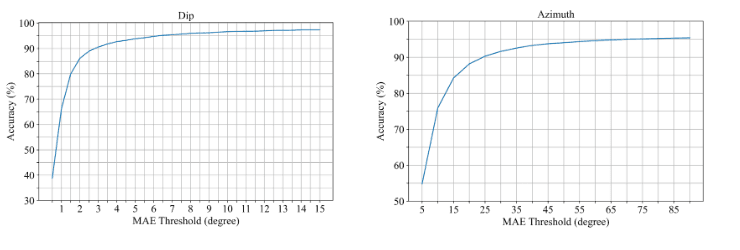Case studies
Redefining Reservoir Analysis with Automated Fracture Detection
Advancing Reservoir Analysis through Automated Fracture Detection in Oil & Gas Exploration.
Get a quote
Summary
We have developed an advanced sinusoid detection solution utilizing cutting-edge deep learning algorithms and artificial intelligence techniques to streamline the identification and characterization of fractures and bedding using Formation Micro Imager (FMI) logs. This comprehensive AI-driven methodology enhances precision adaptability and provides detailed insights into subsurface geological formations, revolutionizing reservoir analysis in the oil and gas industry. Our machine learning models, part of a broader AI analytics framework, significantly improve the accuracy and efficiency of data interpretation, making it a pivotal tool for predictive analytics in hydrocarbon exploration. By leveraging neural networks, our solution sets a new standard for digital transformation in energy resources management.
Duration
12 Months
Team Size
3
01
Challenges
In partnership with CC Energy Development (CCED) in Muscat, Oman, our team pinpointed a significant hurdle in the manual detection of fractures and beddings within Formation Micro Imager (FMI) logs, crucial for reservoir evaluation in carbonate formations. Traditional approaches, including manual and semi-automated techniques, were fraught with limitations such as inherent biases, time-consuming processes, and rigid parameter adjustments. In response, we embarked on creating a groundbreaking Artificial Intelligence (AI) and Machine Learning (ML) driven solution aimed at revolutionizing the process of fracture and bedding detection. This AI-based approach not only promises to overcome the aforementioned challenges but also introduces data-driven insights and automation into the analysis, leveraging advanced algorithms and deep learning to provide accurate, efficient, and bias-free results in geoscience analytics for the oil and gas sector.
As we initiated the process of automating fracture detection in Formation Micro-Imager (FMI) logs through advanced AI and machine learning technologies, the critical importance of precision in AI-driven fracture identification for effective reservoir evaluation became evident. The accuracy of these AI models is crucial, as any deviation could result in incorrect assessments of subsurface geological formations, leading to adverse outcomes. Such inaccuracies can profoundly affect decision-making regarding hydrocarbon pore space evaluation, reservoir dynamics understanding, and strategic planning for resource extraction, with potential financial losses running into millions due to inaccurate reservoir characterization. Consequently, our endeavor to address this challenge was driven by the significant implications for maintaining the integrity of reservoir characterization processes and achieving the strategic objectives of our clients in the energy sector, emphasizing the necessity for cutting-edge AI solutions in petroleum geoscience.
02
Innovation
Our cutting-edge AI-driven solution is at the forefront of developing an advanced Fracture and Bedding Detection Model, utilizing the latest artificial intelligence and machine learning techniques. In collaboration with CC Energy Development (CCED), we aimed to enhance the process of accurately identifying and characterizing fractures and beddings from Formation Micro Imager (FMI) logs. Our comprehensive methodology encompasses a series of critical stages, including data preprocessing, feature extraction, algorithm selection, model training, validation, and deployment, all tailored to meet the specific needs of geological analysis in the oil and gas industry. This AI-based approach not only aims to refine the accuracy and efficiency of subsurface analysis but also sets a new benchmark for innovation in petroleum geosciences, leveraging deep learning and big data analytics to transform traditional reservoir evaluation processes.
Our Fracture Detection Model represents a breakthrough in AI-driven geological analysis, drawing on the innovative Detection Transformer (DETR) architecture. This approach distinguishes our Custom AI Solutions by providing key advantages over conventional models such as YOLO (You Only Look Once) and Faster R-CNN. Our solution's grid-free design is a significant departure from the norm, removing the constraints of a fixed grid and reducing the reliance on extensive post-processing. This transformer-based model excels in accurately identifying both large and small sinusoids directly from the data without the need for significant post-processing, thus enhancing both the speed and precision of the detection process. By leveraging advanced AI techniques and deep learning algorithms, our model sets a new standard for efficiency and accuracy in subsurface analysis, offering a superior alternative for geological feature detection in the oil and gas industry.
 Fig 1 - Architectural design of DETR
Fig 1 - Architectural design of DETR
The core architecture of our model, encompassing the backbone network, transformer modules, and detection head, is intricately designed to meticulously analyze Formation Micro-Imager (FMI) images for precise fracture and bedding detection. By implementing strategic modifications to the backbone architecture, encoder and decoder mechanisms, and optimizing the query process, we've custom-engineered our Advanced AI Algorithms to meet the specific challenges of this application. These tailor-made enhancements significantly bolster our model's capability to identify geological features with high accuracy and efficiency. Our approach leverages deep learning, computer vision, and neural network optimization techniques, setting a new benchmark for AI-powered geological analysis in the oil and gas industry. This nuanced adaptation ensures that our AI model excels in extracting and interpreting complex features from subsurface imagery, paving the way for groundbreaking advancements in reservoir characterization and subsurface analysis.
03
Impact
The deployment of our AI-enabled Fracture Detection Model has led to remarkable achievements, demonstrating exceptional precision and recall in the identification of fractures. It showcases an outstanding ability to predict dip and azimuth with over 90% accuracy, offering in-depth analysis of subsurface geological structures essential for advanced reservoir characterization. Moreover, this AI-driven model dramatically accelerates the analysis process, achieving predictions for a 4-meter depth in merely 10 seconds—a significant improvement that represents a tenfold reduction in time compared to conventional manual techniques. These breakthroughs highlight the unparalleled efficiency and accuracy of our automated AI-Driven Fracture Detection Model, revolutionizing the approach to reservoir characterization and facilitating faster, more informed decision-making within the petroleum industry. By leveraging cutting-edge machine learning algorithms and deep neural networks, our solution sets a new standard for innovation in petroleum geoscience, making it a pivotal tool for enhancing exploration strategies and optimizing resource extraction.
 Fig. 2 - The sensitivity test on our model reveals a >95% accuracy
Fig. 2 - The sensitivity test on our model reveals a >95% accuracy
 Fig 3 - Our AI-driven solution prediction reveals a very good match with that of ground truth (GT), even in complex geological structures. Our solution can accurately interpret this whole section of 4 meters in seconds, a huge improvement from traditional methods.
Fig 3 - Our AI-driven solution prediction reveals a very good match with that of ground truth (GT), even in complex geological structures. Our solution can accurately interpret this whole section of 4 meters in seconds, a huge improvement from traditional methods.
As we envision the future development of our AI-Enabled Fracture Detection Model, our strategy encompasses significant advancements in model sophistication and deployment methodologies. Our focus is on the refinement of the model through the integration of advanced deep learning and transformer-based architectures specifically designed to detect complex fracture networks with unparalleled accuracy. In parallel, our deployment strategy will leverage containerization technologies and cloud computing platforms, ensuring our model's seamless integration and high scalability across varied operational settings. We are also dedicated to enhancing model efficiency by adopting model quantization and employing hardware acceleration techniques to reduce inference times significantly. This approach promises to streamline reservoir characterization processes and enables agile, data-driven decision-making, thereby optimizing the extraction of hydrocarbon resources. By pushing the boundaries of AI technology in geoscience, we aim to lead innovation in digital transformation for the oil and gas industry, setting new standards for accuracy, efficiency, and operational agility in petroleum exploration and development.
We invite collaboration and engagement from industry experts to contribute to our ongoing innovation journey. For more information or to share your perspectives on advancing the capabilities of our AI solution, feel free to contact us.
Impact metrics
Our impact in the vertical
Quantifying our success to showcase how we bring transformative AI solutions to healthcare
10X
increase in interpretation efficiency
>90%
accuracy in identifying fractures
<3 Sec
for every meter interpretation
case studies
Data Assessment Success Stories
How Our Swift Path Methodology Drives Real-World Impact
